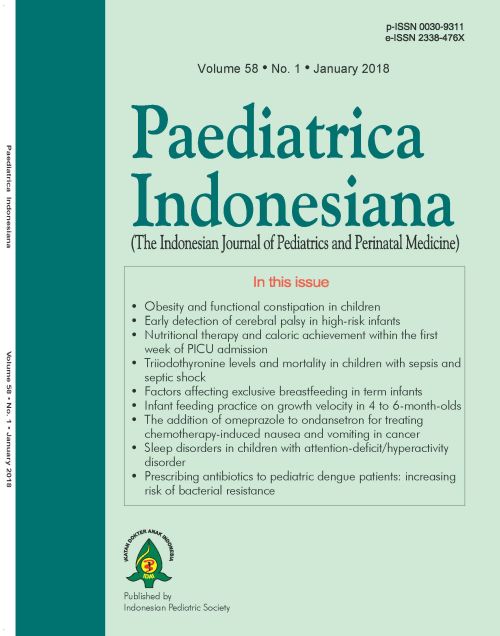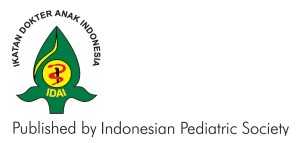The addition of omeprazole to ondansetron for treating chemotherapy-induced nausea and vomiting in pediatric cancer patients
Abstract
Background Chemotherapy-induced nausea and vomiting are some of the most disturbing side effects in pediatric cancer patients. The standard recommendation is the use of 5-hydroxytryptamine 3 receptor antagonist, such as ondansetron, to treat these symptoms. Despite this treatment, more than 50% of patients still experience nausea and vomiting.
Objective To evaluate the effect of the addition of omeprazole to ondansetron in the treatment of chemotherapy-induced nausea and vomiting.
Methods A double-blind, randomized, controlled trial was conducted at Haji Adam Malik Hospital, Medan, North Sumatera, from March to May 2016. Subjects were children aged 1 to 18 years, diagnosed with cancer, and who received intravenous chemotherapy. Patients were randomized to receive either a single dose of ondansetron (0.5 mg/kg) plus placebo or ondansetron (0.5 mg/kg) plus omeprazole (0.5 mg/kg). The severity of nausea and vomiting were measured using the Rhodes index of nausea, vomiting, and retching during the 24 hours after initiation of emetogenic chemotherapy. The primary outcome of efficacy was the proportion of patients who achieved complete response (lack of nausea/vomiting). Statistical analysis was performed by Chi-square and Fischer’s exact tests.
Results Seventy eligible pediatric patients were randomized into two groups: 32 subjects in the ondansetron + placebo group and 38 others in the ondansetron + omeprazole group. The therapy failed in 50% (16/32) of the ondansetron + placebo group and 18.4% (7/38) of the ondansetron + omeprazole group. There was a significant difference in the clinical response between groups (P=0.01).
Conclusion The addition of omeprazole to ondansetron for the treatment of chemotherapy-induced nausea and vomiting is more effective than administration of ondansetron alone.
References
2. Asselin BL. Epidemiology of childhood and adolescent cancer. In: Behrman RE, Kliegman R, Jenson BH, Stanton BF, editors. Nelson textbook of pediatrics. 20th ed. Philadelphia: Saunders; 2016. p. 2016-8.
3. Dewan P, Singhal S, Harit D. Management of chemotherapy-induced nausea and vomiting. Indian Pediatr. 2010;47:149-55.
4. Ballatori E, Roila F. Impact of nausea and vomiting on quality of life in cancer patients during chemotherapy. Health Qual Life Outcomes. 2003;1:46.
5. Phillips RS, Friend AJ, Gibson F, Houghton E, Gopaul S, et al. Antiemetic medication for prevention and treatment of chemotherapy-induced nausea and vomiting in childhood. Cochrane Database Syst Rev. 2016;2:CD007786.
6. Jordan K, Sippel C, Schmoll HJ. Guidelines for antiemetic of chemotherapy-induced nausea and vomiting: past, present, and future recommendations. Oncologist. 2007;12:1143-50.
7. Jaing TH, Tsay PK, Hung IH, Yang CP, Hu WY. Single dose oral granisetron versus multidose intravenous ondansetron for moderately emetogenic cyclophosphamide-based chemotherapy in pediatric outpatients with acute lymphoblastic leukemia. Pediatr Hematol Oncol. 2004;21:227-35.
8. Holdsworth MT, Raisch DW, Frost J. Acute and delayed nausea and emesis control in pediatric oncology patients. Cancer. 2006;106:931-40.
9. Kurucu N, Durmaz M. Effect of hydroxyzine in controlling acute chemotherapy-induced vomiting in children: a randomised trial. Int J Hematol Oncol. 2012;22:99-106.
10. Navari RM. Management of chemotherapy-induced nausea and vomiting in pediatric patients. Paediatr Drugs. 2017;19:213-22.
11. Navari RM. Pathogenesis-based treatment of chemotherapy-induced nausea and vomiting--two new agents. J Support Oncol. 2003;1:89-103.
12. Stringer AM, Gibson RJ, Bowen JM, Keefe DM. Chemotherapy-induced modifications to gastrointestinal microflora: evidence and implications of change. Curr Drug Metab. 2009;10:79-83.
13. Riezzo G, Clemente C, Leo S, Russo F. The role of electrogastrography and gastrointestinal hormones in chemotherapy-related dyspeptic symtoms. J Gastroenterol. 2005;40:1107-15.
14. Nelson K, Walsh D, Sheenan F. Cancer and chemotherapy-related upper gastrointestinal symptoms: the role of abnormal gastric motor function and its evaluation in cancer patients. Support Care Cancer. 2002;10:455-61.
15. Tiligada E. Chemotherapy: induction of stress responses. Endocr Relat Cancer. 2006;13:115-24.
16. Richardson J, Smith JE, McCall G, Richardson A, Pilkington K, Kirsch I. Hypnosis for nausea and vomiting in cancer chemotherapy. Eur J Cancer Care. 2007;16:402-12.
17. Polikandrioti M, Evaggelou E, Zerva S, Zerdila M, Koukoularis D, Kyritsi E. Evaluation of depression in patients undergoing chemotherapy. Health Sci J. 2008;2:162-72.
18. Pandey M, Sarita GP, Devi N, Thomas BJ, Hussain BM, Krishnan R. Distress, anxiety, and depression in cancer patients undergoing chemotherapy. World J Surg Oncol. 2006;4:68-73.
19. Deghani SM, Imanieh MH, Oboodi R, Haghighat M. The comparative study of the effectiveness of cimetidine, ranitidine, famotidine, and omeprazole in treatment of children with dyspepsia. ISRN Pediatr. 2011;2011:219287.
20. Rhodes VA, McDaniel RW: The index of nausea, vomiting, and retching: a new format of the Index of nausea and vomiting. Oncol Nurs Forum. 1999;26:889-94.
21. Marx W, Ried K, McCarthy AL, Vitetta L, Sali A, McKavanagh D, et al. Ginger mechanism of action in chemotherapy-induced nausea and vomiting: a review. Crit Rev Food Sci Nutr. 2017;57:141-6.
22. Czinn SJ, Blanchard SS. Developmental anatomy and physiology of the stomach. In: Wyllie R, Hyams JS, editors. Pediatric gastrointestinal and liver disease. 4th ed. Philadelphia: Elsevier; 2011. p. 262-8.
23. Riezzo R, Clemente C, Linsalata M, D’Attamo B, Orlando A, Campanella G, et al. Gut peptide profile and chemotherapy-associated dyspepsia syndrome in patients with breast cancer undergoing FEC60 chemotherapy. Anticancer Res. 2013;33:4951-8.
24. Barret KE. Gastric Secretion. In: Malley J, Naglieri C, editors. Gastrointestinal physiology. 1st ed. New York: McGraw-Hill; 2006. p. 37-56.
25. Sultani M, Stringer AM, Bowen JM, Gibson RJ. Anti-inflammatory cytokines: important immunoregulatory factors contributing to chemotherapy-induced gastrointestinal mucositis. Chemother Res Pract. 2012:2012:490804.
26. Yanez JA, Teng XW, Roupe KA, Fariss MW, Davies NM. Chemotherapy induced gastrointestinal toxicity in rats: involvement of mitochondrial DNA, gastrointestinal permeability and cylooxygenase-2. J Pharm Pharm Sci. 2003;6:308-14.
27. Sontakke S, Thawani V, Naik MS. Ginger as an antiemetic in nausea and vomiting induced by chemotherapy: a randomized, cross-over, double blind study. Indian J Pharmacol. 2003;35:32-6.
28. Pillau AK, Sharma KK, Gupta YK, Bakhshi S. Anti-emetic effect of ginger powder versus placebo as an add-on therapy in children and young adults receiving high emetogenic chemotherapy. Pediatr Blood Cancer. 2011;56:234-8.
29. Sartori S, Trevisiani L, Nielsen I, Tassinari D, Panzini I, Abbasciano V. Randomized trial of omeprazole or ranitidine versus placebo in the prevention of chemotherapy-induced gastroduodenal injury. J Clin Oncol. 2000;18:463-7.
30. Hilarius DL, Kloeg PH, van der Wall E, van den Heuvel JJ, Gundy CM, Aaronsen NK. Chemotherapy-induced nausea and vomiting in daily clinical practice: a community hospital-based study. Support Care Cancer. 2012;20:107-17.
31. Siddique R, Hafiz G, Jamal CY, Karim A, Islam A, Alia RA. Randomized double blind trial to compare the efficacy of granisetron and ondasetron in controlling emesis in children with acute lymphoblastic leukemia. Bangladesh J Child Health. 2012;36:115-21.
32. Salihah N, Mazlan N, Lua PL. Chemotherapy-induced nausea and vomiting: exploring patients’ subjective experience. J Multidiscip Healthc. 2016;9:145-51.
33. Lorusso V. Management of chemotherapy-induced nausea and vomiting by risk profile: role of netupitant/palonosetron. Ther Clin Risk Manag. 2016;12:917-25.
Authors who publish with this journal agree to the following terms:
Authors retain copyright and grant the journal right of first publication with the work simultaneously licensed under a Creative Commons Attribution License that allows others to share the work with an acknowledgement of the work's authorship and initial publication in this journal.
Authors are able to enter into separate, additional contractual arrangements for the non-exclusive distribution of the journal's published version of the work (e.g., post it to an institutional repository or publish it in a book), with an acknowledgement of its initial publication in this journal.

This work is licensed under a Creative Commons Attribution-NonCommercial-ShareAlike 4.0 International License.
Accepted 2018-02-15
Published 2018-03-20












